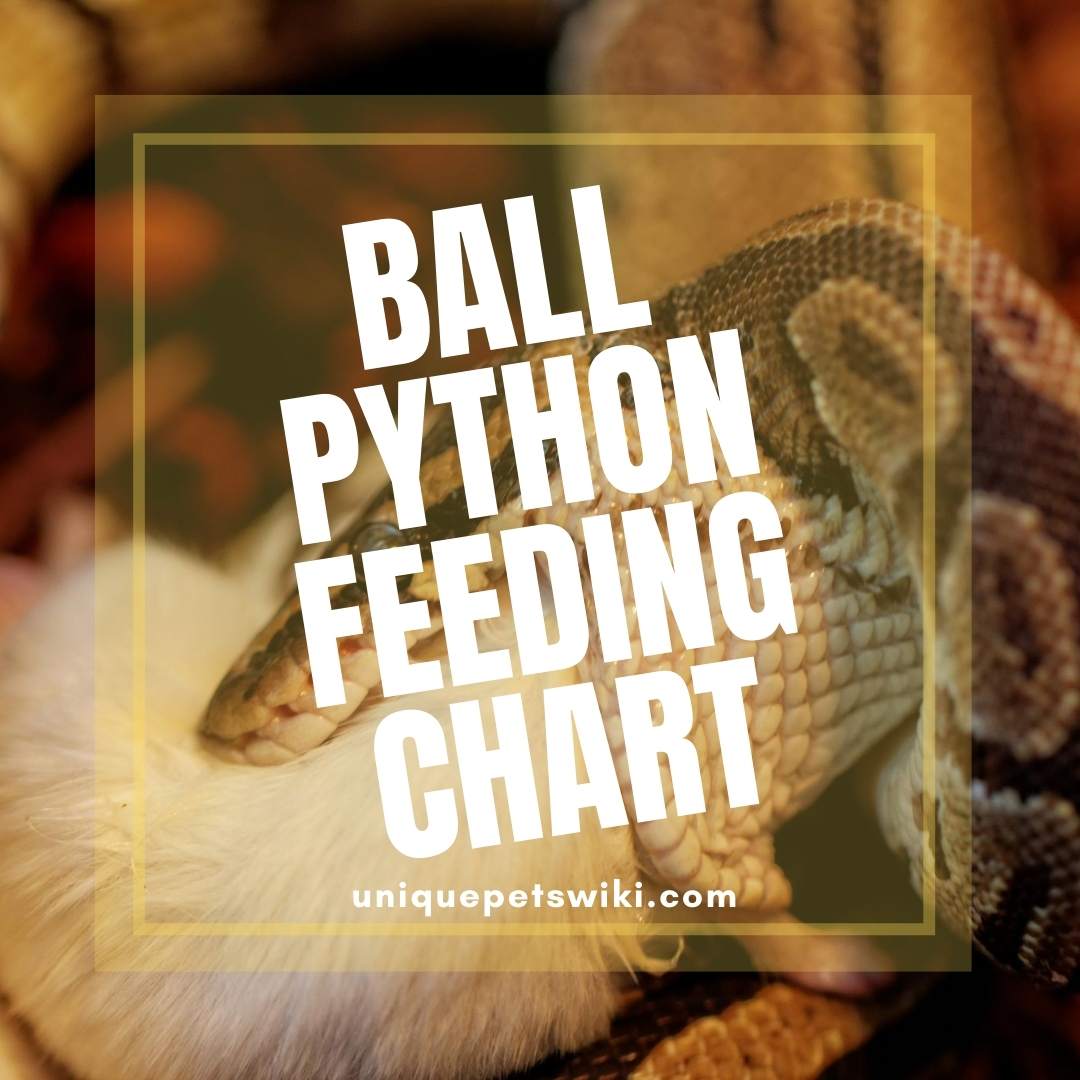Do you have trouble feeding your ball pythons? What if I give you a well planned-out feeding chart for ball pythons to make your husbandry easy? We will talk about ball python feeding chart in this article.
Ball pythons make good pet snakes to both new and experienced herpetologists. For one reason, their varying colorful morphs and the other for their docile nature and relatively low maintenance cost.
Even with this, a common challenge among ball python owners in captivity is getting their pet snakes to eat regularly just like other animals. It is believed that ball pythons aren’t as good eaters as other species of snakes.
Therefore, some ball python owners find it difficult to feed their pet snakes mostly during winter. Ball pythons like other snakes prey on varying sizes of mammals based on their gender and age or size.
A common belief held by most ball python breeders is that you should only feed various life stages of rats throughout the entire life of your ball python and never offer any insects or mice.
However, this is just one of the myths of ball pythons and it’s not true. Imagine as a human, being offered only one kind of food throughout your entire life. It’ll suck, right? Similarly, your ball pythons need various kinds of food and in certain quantities and at certain ages.
In this regard, this article will give you a detailed feeding chart for your captive-bred ball pythons. Also in this article, you’ll learn the best tips on how to feed your hatchlings, juvenile, and adult ball pythons.
Why do you need to learn how to feed your pet ball python?
Feeding your pet ball pythons with a proper python diet is a critical part of their husbandry to keep them healthy. Thus your understanding of what they eat, how much they need food, how often they should be fed, and their dietary preferences is important to be a good keeper.
Let’s continue reading
Contents
The Complete Feeding Chart For Your Ball Pythons
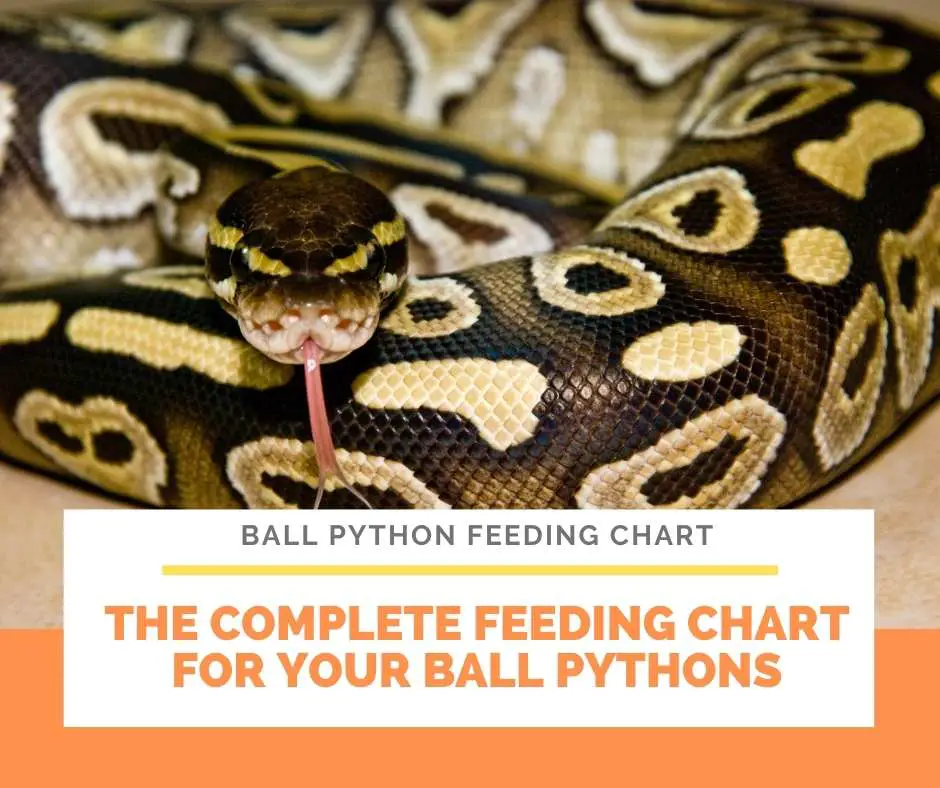
Ball pythons in the wild feed on small animals (rodents) and birds. As earlier stated, the exact type of rodent they prey on is influenced by their gender and size. Therefore in the wild, males who are arboreal in nature feed mainly on birds while females subsist on small rodents.
Understanding their needs in the wild is key to having a hitch-free feeding. A very important point to note when feeding your pet ball python is not to base the size or type of prey on their age, as most snakes grow faster and look bigger than their age.
So it is best and safe to choose food based on their size and individual’s need rather than age. Going by feeding your snake based on size, note that your snake will easily consume a prey as large as the widest part of its body.
Therefore, if the middle part of its body is just one inch wide, it should be able to consume a mouse that is one inch wide or less without any trouble.
Feeding your ball pythons with prey larger than their size will only result in a condition called regurgitation. A situation your snake tries to vomit what it has swallowed, or the prey will just get stuck in the esophagus.
That being said, here is a well-planned out feeding chart for ball pythons in captivity. Read up for more information on how to feed your pet ball python at its different life stages.
| Ball Pythons’ Weight (g) | Size Of Feed (g) | Common Name | How Often To Feed |
| Hatchlings – 99 | 9 – 12 | Hopper mice. | Every 5-7 days. |
| 100 – 199 | 13 – 20 | Weaning mice or small rat pups. | Every 5-7 days. |
| 200 – 349 | 21 – 30 | Fuzzy mouse, rat pups. | Every 5-7 days. |
| 350 – 499 | 31 – 45 | Rat weanling. | Every 7 days. |
| 500 – 799 | 46 – 79 | Small rat. | Every 7 days. |
| 800 – 1,499 | 80 – 149 | Medium-sized rat. | Every 7-10 days. |
| 1,498 – 2,499 | 150 – 265 | Large rat. | Every 7-14 days. |
| 2,499 and above | 266 – 360 | Large or Extra-large rat. | Every 14 days or more. |
Feeding Your Hatchlings
Ball pythons are oviparous, meaning that they lay eggs in clutches and hatch the same after six to eight weeks into babies. At birth, hatchlings measure approximately 10 inches long and during this early stage, they may not accept food until after two weeks when they had their first shed.
Once your hatchlings are ready to eat, feed them either crawler mouse, one pinky rat, pinky mouse, or rat pups every 5 days. After this stage when the snake is about 6-7 months old, you can rotate prey to include mice and small rats.
Note that offering your pet snakes varieties of prey at an early stage like this will ensure that they don’t grow to become picky eaters.
Feeding Your Juvenile Ball Pythons
It takes about 4-6 months for hatchlings to grow to the juvenile stage. At this stage, they would weigh between 100-500 grams and should be fed with fuzzy or pinky rats once in a week or every 7 days interval.
Feeding Your Adult Ball Pythons
It is normal to some extent for your adult pet snakes to refuse food for some time. If there is no significant weight loss then there isn’t any need to get worried. Adult ball pythons are known to survive for months without food while babies can only go for a few weeks without food.
At this stage, they should be fed medium-sized prey such as rats every 7-10 days. Since they are known to be picky eaters at adulthood, you may experience some difficulty enticing them to eat.
Should your pet snakes become hesitant to eat, here are simple feeding tips to get your adult ball python interested in eating:
Make Sure That Your Python Is Healthy
Your adult ball python will refuse food if he is sick. To ensure that your snake is in good health conditions, first, evaluate your husbandry and be sure that his habitat is in ideal conditions after which you can visit the vet should you detect any health issue.
With a pair of long tongs or forceps gently lower the frozen-thawed rodent down in its enclosure in front of your snake to see if he will attack it. The rodent is best held by the tail or by the neck and avoid distracting your snake which may in turn constitute stress.
If your snake still appears uninterested, try animating the prey by dangling it in front of your snake to make it look alive.
If your pet snake appears interested in the frozen-thawed rodent, release it once your snake strikes it. Once your snake is done eating, clean up the habitat of any mess and close the enclosure.
Can Ball Pythons Eat Frozen Food?
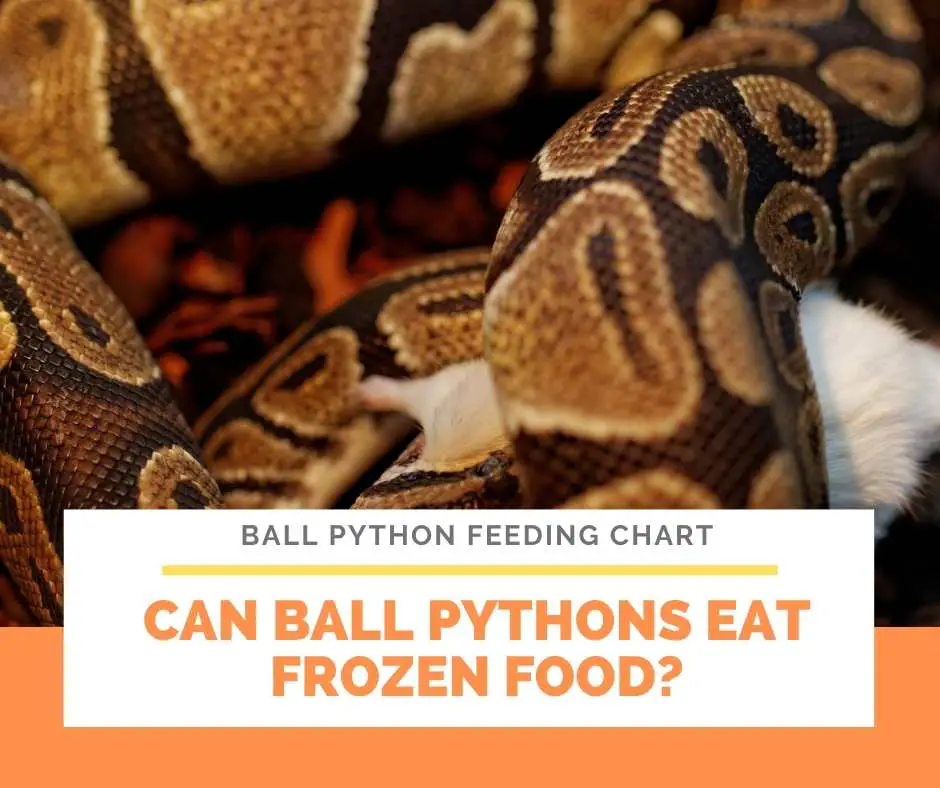
Feeding your pet ball pythons live prey isn’t entirely ideal or recommended. Because in the process, the prey might try to defend itself and can cause harm to your snakes.
Most of the problems breeders have with feeding their captive ball pythons is that they don’t like eating pre-killed foods such as rats and mice. Nonetheless, pre-killed foods both frozen and fresh is the safest way to feed them.
To get started, obtain a frozen rodent (either rats or mice) of an appropriate size to your snake and make sure that after thawing the rodent, it is warmed up to room temperature before you can feed it to your snake.
This way you can be sure that there is no possibility of the prey injuring your snake or the rodent suffering and trying to escape.
Can I Use This Ball Python Feeding Chart For Other Pet Snakes?
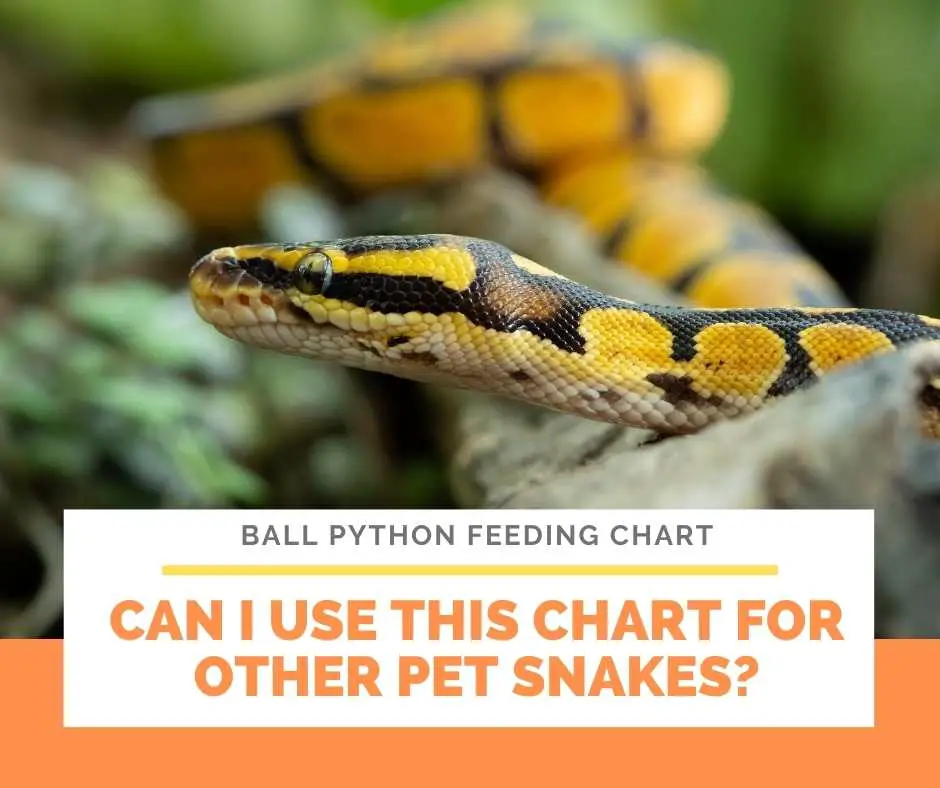
All kinds of snakes are carnivores which means they prey primarily on other animals. As for other types of snakes other than ball pythons, the exact prey they feed on is dependent on their species.
While some species of snakes eat warm-blooded rodents such as rats, rabbits, birds; others prey on amphibians (such as toads and frogs), insects, eggs, fish, slugs, earthworms, and other reptiles.
Your knowledge of what kind of food your snake species need is vital to be on the safe side. If your pet snake is similar in species to ball pythons (that is if your pet snake preys on warm-blooded rodents in the wild), then you can use this feeding chart on it as well.
However, if your pet snake is different in species and dietary requirements from ball pythons, only stick to feeding it with its kind of food.
Conclusion
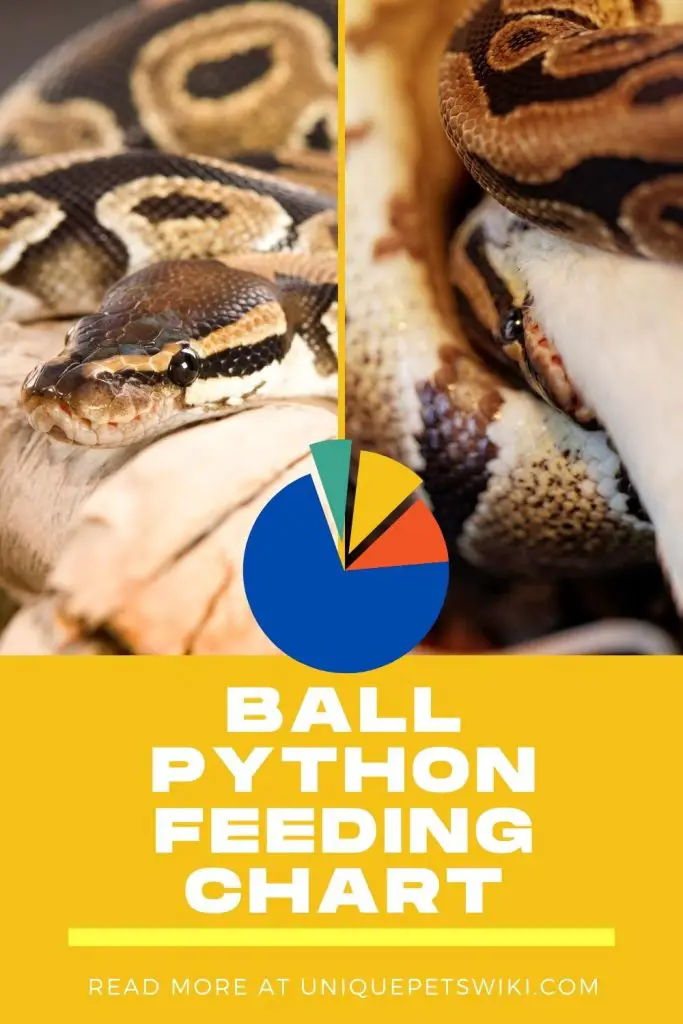
In the wild, ball pythons eat a variety of rodents (small animals) such as mice, gerbils, chicks, and birds. In captivity, they should be offered a variety of foods at different stages of their lives like every other animal.
The case of always feeding your pet snake only one type of prey at a particular stage is the problem of transition. This is when you practically have difficulty getting your ball python to eat. To ensure that this doesn’t occur, variety is the rule of thumb.
